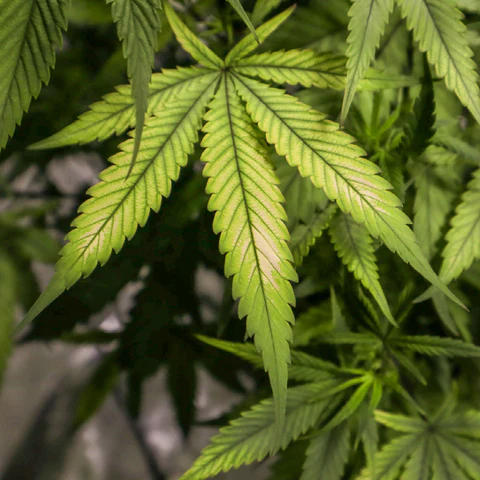Cannabis nutrient lockout is a potentially fatal problem if left unresolved, and is often misdiagnosed by new growers.

A misdiagnosis of a cannabis nutrient lockout can lead to disaster because many growers will take uninformed corrective measures without actually fixing the underlying issue. It is our hope that this beginner guide to nutrient lockout will help you to correctly identify cannabis nutrient lockout symptoms, teach you how to avoid nutrient lockout, and how to treat nutrient lockout symptoms.
What Is Nutrient Lockout?
Nutrient lockout is a term that means essential nutrients in your medium or reservoir are unavailable to a cannabis plant’s roots. This typically occurs as the result of a chemical reaction in a hydroponics solution or in the medium (soil/coco). A nutrient lockout during flowering could significantly reduce your yield at harvest time, if left unattended before corrective measures have been taken. A nutrient lockout during vegetative growth (first two months), is often quite easily corrected, with a plant having ample time to recover. One can also add additional vitamins like Vitamin B1 in Future Harvest’s Super B+ to help aid in a fast recovery and fortify a cannabis plant’s immune system.

What Causes Nutrient Lockout?
For nutrients to become bioavailable to the root, certain parameters must be met. If you are growing in excessively acidic or alkaline conditions, you will throw certain essential nutrients out of the optimal range for absorption by the root, causing lockout to occur. If lockout is not addressed through monitoring pH and EC, visible nutrient deficiencies will follow.
Though a new grower may see a symptom of a nutrient deficiency and add more fertilizer to address the problem, nutrient lockouts also commonly occur due to excessive concentrations of fertilizer in the media or hydroponic solution. The salt build-up in the media or hydroponic solution, causes the pH to rise above the optimal range. The abundance of one essential nutrient can actually block the absorption of others. The result will be a cannabis nutrient deficiency. If left untreated, a plant could die from starvation despite the concentrations of nutrients in the soil.
Because nutrients are absorbed into the root by osmosis, if the media or solution at the root zone has a high concentration of dissolved salts (fertilizer), a cannabis plant can actually leach nutrients from the roots into medium instead of the other way around.

How To Avoid Nutrient Lockout:
The safe bet when encountering a cannabis nutrient lockout is actually the opposite of adding more fertilizer. The grower should flush the media of excess salts (fertilizer), drain the reservoir, and remix the nutrient solution at the corrected doses, monitoring for optimal pH (5.8-6.2) and EC/PPM along the way.
As previously stated it is paramount to find quality 100% water soluble nutrients that a plant’s roots can immediately access. Novice hydroponic growers should start by sourcing quality base nutrients like the Holland Secret (Grow/Micro/Bloom), because they are formulated to provide your plants with all the essential nutrients they need to reduce the chance of nutrient lockout.
For soil and coco growers, you can’t go wrong with our Easy Plus Grow and Bloom. The Easy plus series will automatically adjust your pH into a plant friendly range with just a couple teaspoons in a watering can. This makes Future Harvest’s Easy Plus a go-to fertilizer for many new cannabis growers.

Another way to avoid a nutrient lockout is through the daily monitoring of your pH and EC (ppm) readings. The easiest way to accomplish this is to invest in a quality pH/EC (ppm) meter. Nutradip’s Growboss is perfect for hydroponic growers, with a digital display and probes that can remain submerged for continual monitoring. The Growboss provides accurate digital reading of nutrient concentration (PPM’s), the pH and your solution’s temperature.

Those growing in soil should always test the pH and EC of their fertigation water prior to feeding. Testing the soil (not the water) for pH and EC can be done by using the pour-thru method, the saturated media extraction method or the 2:1 technique, as described in our blog EC 101.
For those on a restricted budget, pH test strips are a good place to start to verify your pH is in a plant-friendly range. To test EC or PPM, a handheld nutrient meter like an HM COM-80, can do the trick without breaking the bank. One should regularly calibrate their meters, using calibration solutions like Nutradip’s 1000 ppm calibration solution.
Next Steps Relating To Nutrient Lockout For Cannabis Growers:
Let’s say you think you are seeing a possible lockout due to a cannabis deficiency symptom in your crop, ask yourself these questions:
Am I watering with a solution using the recommended doses of fertilizer to fresh water?
Am I using water that has been accurately measured for optimal pH and EC ranges?
Are my environmental parameters like light, temperature, humidity and airflow creating a plant-friendly growing environment?
If you’ve answered yes to all of these questions, yet you are still seeing lockout symptoms in the form of a deficiency, it may be time to explore the signs and symptoms of specific cannabis nutrient deficiencies further.
Check out this blog about common nutrient deficiencies that occur in cannabis, their symptoms, how to diagnose nutrient deficiencies and how to treat them.
Do you like cannabis cultivation articles like this? Check out our blog and if you’re looking for an easy way to diagnose plant deficiencies, our friends at Growdocapp have a great app for doing just that. Simply snap a photo and it’ll bring up a potential diagnosis and treatment options.











Leave a comment